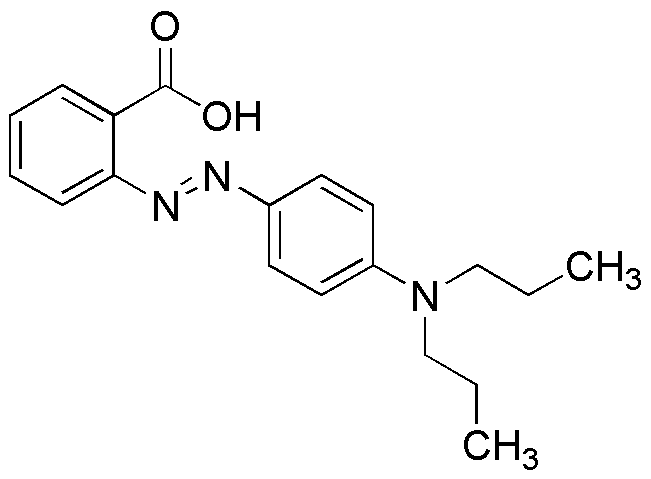Propyl Red is widely utilized in research focused on:
- Colorimetric Analysis: This compound is often used as a pH indicator in various chemical analyses, providing clear visual changes that help researchers determine acidity or alkalinity in solutions.
- Biological Staining: In microbiology, Propyl Red serves as a vital stain for visualizing cellular structures, aiding in the identification and classification of microorganisms.
- Textile Industry: It is employed as a dye in the textile sector, offering vibrant colors that are resistant to fading, thus enhancing the longevity and appeal of fabrics.
- Analytical Chemistry: Researchers utilize Propyl Red in chromatography as a marker to track the movement of compounds, facilitating the separation and identification of chemical mixtures.
- Environmental Monitoring: This compound can be used in environmental studies to detect pollutants, providing a practical tool for assessing water quality and safety.
General Information
Properties
Safety and Regulations
Applications
Propyl Red is widely utilized in research focused on:
- Colorimetric Analysis: This compound is often used as a pH indicator in various chemical analyses, providing clear visual changes that help researchers determine acidity or alkalinity in solutions.
- Biological Staining: In microbiology, Propyl Red serves as a vital stain for visualizing cellular structures, aiding in the identification and classification of microorganisms.
- Textile Industry: It is employed as a dye in the textile sector, offering vibrant colors that are resistant to fading, thus enhancing the longevity and appeal of fabrics.
- Analytical Chemistry: Researchers utilize Propyl Red in chromatography as a marker to track the movement of compounds, facilitating the separation and identification of chemical mixtures.
- Environmental Monitoring: This compound can be used in environmental studies to detect pollutants, providing a practical tool for assessing water quality and safety.
Documents
Safety Data Sheets (SDS)
The SDS provides comprehensive safety information on handling, storage, and disposal of the product.
Product Specification (PS)
The PS provides a comprehensive breakdown of the product’s properties, including chemical composition, physical state, purity, and storage requirements. It also details acceptable quality ranges and the product's intended applications.
Certificates of Analysis (COA)
Search for Certificates of Analysis (COA) by entering the products Lot Number. Lot and Batch Numbers can be found on a product’s label following the words ‘Lot’ or ‘Batch’.
*Catalog Number
*Lot Number
Certificates Of Origin (COO)
This COO confirms the country where the product was manufactured, and also details the materials and components used in it and whether it is derived from natural, synthetic, or other specific sources. This certificate may be required for customs, trade, and regulatory compliance.
*Catalog Number
*Lot Number
Safety Data Sheets (SDS)
The SDS provides comprehensive safety information on handling, storage, and disposal of the product.
DownloadProduct Specification (PS)
The PS provides a comprehensive breakdown of the product’s properties, including chemical composition, physical state, purity, and storage requirements. It also details acceptable quality ranges and the product's intended applications.
DownloadCertificates of Analysis (COA)
Search for Certificates of Analysis (COA) by entering the products Lot Number. Lot and Batch Numbers can be found on a product’s label following the words ‘Lot’ or ‘Batch’.
*Catalog Number
*Lot Number
Certificates Of Origin (COO)
This COO confirms the country where the product was manufactured, and also details the materials and components used in it and whether it is derived from natural, synthetic, or other specific sources. This certificate may be required for customs, trade, and regulatory compliance.


